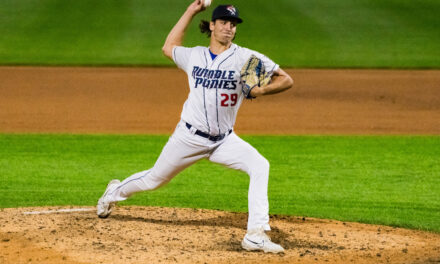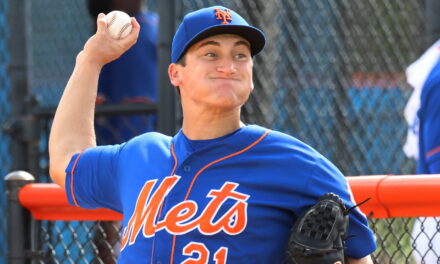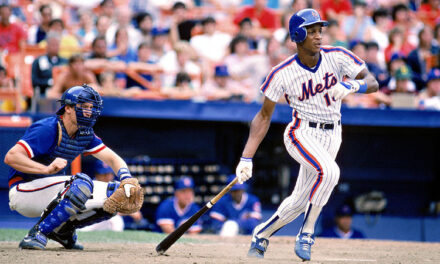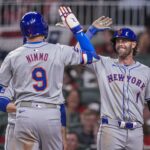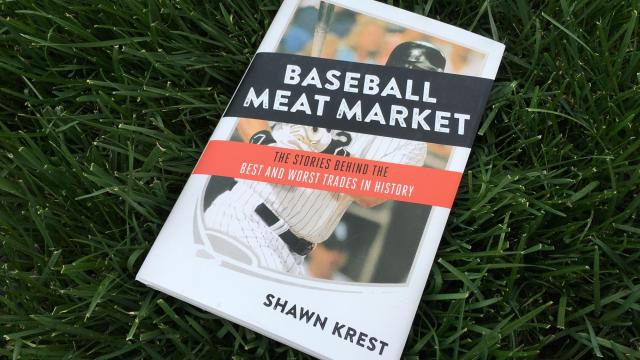
Reliving baseball trades can either be a fun trip down memory lane, or it can leave fans regretting the decisions their teams’ front offices made.
Author Shawn Krest wanted to identify some of baseball’s very best and worst trades in his new book, Baseball Meat Market: The Stories Behind the Best and Worst Trades in History. Krest included detailed reports on the behind the scenes work that takes place to foster these deals, which most fans never hear about.
He brings readers into the front office, so to speak, reporting on how certain deals came to fruition, and why the deals got done or in some cases, fell through.
Krest highlights all the moving parts that go into constructing a deal, and how we as fans and media alike often overlook the human element that takes place when players are traded away. Krest also included the traded players’ WAR before and after the deals, trying to draw conclusions and analyze which deals worked out best, or if a team gave up far too much.
I had the privilege of speaking with Krest, and discussed some of the chapters in his book, including ones on Mike Piazza, Bartolo Colon and Alex Rodriguez.
MMO: What gave you the idea to write this book about the various trades in baseball history, and assessing the value for the clubs involved?
Shawn: When I was growing up in the eighties and early nineties, my family subscribed to Baseball Digest. It seemed like every season or so there would be an article about the ten biggest mismatches in trade history and things like that. It was always kind of the same ten trades. Once I started doing baseball writing for a living, I wanted to revisit that and say, now it’s a generation later and I feel like fans are a little more sophisticated about understanding some of the reasons behind the trade.
They understand the idea about being a seller and sometimes you’re going to get rid of good players to rebuild. I wanted to revisit it based on that, based on the fact that the fans are a little more sophisticated now and understand more of that. To really get into what goes on, how do you become a player to be named later, what’s that like to be that guy for the rest of the season, and things like that. Some of the stories that don’t get told a lot of times as you’re looking at the headline of a trade.
MMO: You talk in the book about the stories that go on behind the scenes, and the nuances the average fan might not be aware of. Was that a big motive for you to share with the fans?
Shawn: Yeah, exactly. I lived for a long time in Rochester, N.Y., I lived in Durham, N.C., so I’ve been around a lot of minor league baseball, and that’s where it really gets personal.
Around trade deadline, you can really see these are the guys that are going to get thrown in [to deals]. That aren’t going to get mentioned on SportsCenter, but are going to have to pack up and they’re going to leave behind wives or trying to deal with the leases and things like that.
I feel like just from that, you get a more personal feeling about the trade. I think that’s what spurned me on to want to look at that side of it and see how it affects these guys. They’re not just pieces of meat, they’re human beings and it’s a pretty traumatic experience for some of them.
MMO: How long did the whole process of writing the book take?
Shawn: It took me about a season. A season to research, travel around and talk to people. And then the writing took a couple of months after that. I was writing as I went along as much as I could, and then it was probably about two months of just sitting down and this is going to be my life for the foreseeable future to get it all written.
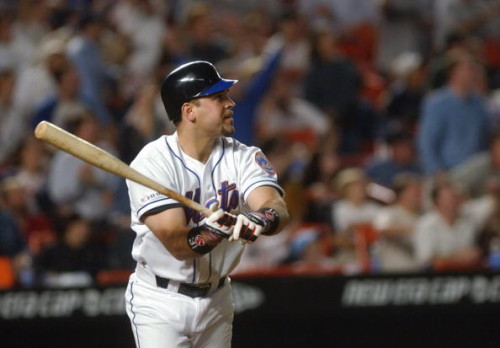
MMO: A trade Mets fan will never forget is the one that sent Mike Piazza to New York from the Florida Marlins in 1998. That trade came together in a week after Piazza arrived in Florida. Can you talk a bit about the original trade that sent Piazza from the Dodgers to the Marlins, and how it became contentious with demands and such?
Shawn: I led off with that one because I feel like it’s a good example of kind of the struggle I had. I knew what I wanted to do with the book but once you get into picking the trades it’s a bit of a struggle. If you’re a fan of one team, if you’re a Mets fan, it’s real easy to pick out which are the good trades and which are the bad trades. Getting Tom Seaver was a good trade [winter of 1982], but getting rid of Nolan Ryan was probably not.
When you’re looking at a baseball perspective, it’s kind of tough to do that. In the Nolan Ryan trade, the Angels will say that’s one of the best trades they ever made. So what should that count as? I think what I did is put myself in a position of commissioner of baseball really, and talk about the best interests of baseball. Is this a trade that helped make the game better?
I think the Piazza trade is a great one to start with just because, regardless of who got what, at the end of that whole experience, I don’t think anybody is going to say that what went on was really good for the game. It wasn’t necessarily a team getting ripped off or anything like that, it’s just the reasons for the trade and what went on kind of left everybody with a bad taste in their mouth, even the Mets who ended up getting a future Hall of Famer in the deal. I felt like that was a good one to start the book with.
MMO: The Dodgers offered Piazza a sizable contract, but Piazza wanted to be the highest-paid player in the game. Was it all about just having the veneer of being the highest-paid player for Mike?
Shawn: I think so. These are competitive guys and all along they wanted to be the best, and so I feel like he was thinking this is how you measure at this level who’s the best. And so I deserve this, this should be me; not really thinking about how that’s going to appear to average fans.
Looking back on it, over time, it’s easy to understand that sentiment. It’s just hard to justify that in a sound bite when you’re talking to a TV reporter which is what happened to him in Los Angeles. The fans turned on him almost instantaneously once his [Piazza] comments came out.
I think it was a way for him to keep score more so than the money, and it just didn’t end well for him really [in L.A.].
MMO: Another player with Met ties is Bartolo Colon, who you dedicate a chapter to. Obviously, Montreal sent a haul in retrospect for Colon in 2002 [Grady Sizemore, Cliff Lee, Lee Stevens, and Brandon Phillips], but can you talk about the job Omar Minaya did with the trade? Especially with such a strict and limited budget considering MLB took control of the Expos.
Shawn: He [Minaya] was in an almost impossible situation there. They knew the team wasn’t going to be there long term, and everybody in the organization knew that he was kind of a lame duck. Everybody in baseball knew that he was a lame-duck, which also makes it tough when you’re negotiating when you’re trying to get one of these deals, because they know you’re not going to be around for long.
He was in the position of, kind of like Major League, in the movie scenario, where the best thing we can do is if we can get it together and have a magical team and win this, maybe we can save baseball here.
That’s why he was willing to sacrifice so much in order to bring that in. He wanted to make that statement that we’re still here, we’re still competing for this, and we’re not going to be here in the future, so mortgaging the future doesn’t really have a definition for us or for our fans at this point, so it’s worth giving this a try.
MMO: One potential trade you talk about in a later chapter that never materialized was sending Miguel Cabrera from Florida to the Los Angeles Dodgers for Matt Kemp, Andy LaRoche, and then prospect Clayton Kershaw. Why would the Marlins have turned that down?
Shawn: [Laughs.] That’s a good question! That’s one of the interesting things that I came across is, not just the trades that were made, but a lot of times, a trade is evaluated based on what you could’ve gotten. Kind of the opportunity cost for it.
That’s an example where they were offered a king’s ransom for it, and it was just a question, of which prospects do we want? Which contracts do we want to take on? I think Kemp’s contract was a concern for them at the time. And for whatever reason, they just didn’t value Kershaw’s play highly as it turned out to be.
MMO: Was there one particular rumored trade that took you by surprise when you were doing your research?
Shawn: That one [Kershaw] was surprising and the chapter on David Wells, where he was traded was one I wasn’t even sure was going to make the cut for the book until I found out about the Yankees’ last-minute offer. They decided that it was too expensive and they weren’t going to be able to bring him in. At the last, minute George Steinbrenner called up and offered Jorge Posada and Mariano Rivera.
And inexplicably, the Tigers didn’t take them up on that and ended up dealing him to the Reds. Eventually, he did make his way to the Bronx.
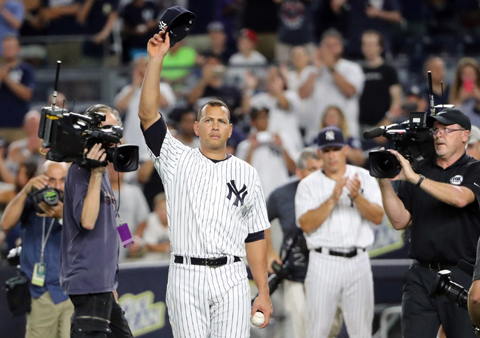
MMO: Another big chapter in your book was on the Alex Rodriguez non-trade to the Boston Red Sox, and then the deal that sent him from the Texas Rangers to the New York Yankees. Brian Cashman and then GM John Hart seemed to have worked this out under the radar. Can you talk a bit about this trade and how it came about?
Shawn: Yeah, and a lot of times, when you have a fantasy team, you don’t really think about these guys as people. A lot of times, these trades are spurned on by personalities. Either a guy doesn’t get along with his teammates and in baseball, you’re there every day, and so, if there’s conflict like that, little things are going to get very big by the end of the season. But a lot of times it’s just one-on-one conversations, personal interactions and things like that.
That was an example of that.
One reason that trade took place is that Cashman and A-Rod happened to be seated together at the Writers’ Dinner in the off-season. They were there all night at the head table talking and eventually the idea of coming and playing third base because they had just lost Aaron Boone to that basketball injury, that came up.
If the seating chart had been different that night who knows what the American League East or the American League West would look like for the next few years.
MMO: The Yankees gave a list of five prospects for the Rangers to pick from, along with shipping Alfonso Soriano to the Rangers. They picked 19-year-old shortstop Joaquin Arias, but there was a prospect on that list who became a seven-time All-Star and five-time Silver Slugger winner. Can you talk about why the Rangers chose Arias over Robinson Cano?
Shawn: I think a lot of times it’s just more major league ready, we’re going to be able to use him sooner, and things like that. Where if he’s a year ahead in the system, or he’s just that much closer, especially a big trade like that where you’re trading away such a big name, you want to be able to show benefits earlier, even if the benefits would’ve been much greater had you taken the other guy.
I thought a lot of the attitude towards prospects that executives have is very different from the way that it was in my mind, and the way I think a lot of fans think about it. They don’t worry so much about what’s this guy going to do when we trade him away.
I asked some of the general managers that you drafted this guy, you scouted him, you have a relationship with him, now when you trade him away do you start rooting against him? And they said no, we don’t do that at all. It’s kind of like if a friend of yours has a birthday, and you just buy a couple of lottery tickets to put in his card. It doesn’t really matter to you personally whether those tickets pay off or not, it’s just the idea that you’re giving them a chance.
That’s how they look at throwing prospects into a deal. We’re giving you this chance and that chance has this much value in the trade. But it doesn’t make me a better or worse general manager if you happen to get a winning lottery ticket.
MMO: That’s really interesting about the view on prospects. I know you wrote in great detail about the prospects that were dealt in the Mark Teixeira trade with the Atlanta Braves in ’07, it must be tough for scouts and executives to see these guys dealt after devoting so much time to scouting and development.
Shawn: Yes, both for the executive and obviously for the player. A lot of times, if the player even knew he was included on that list, even if the other team didn’t take him, that would be upsetting to them. I talked to some farm directors and they said that first time you’re traded it’s like your first love, you never forget it. They start sometimes in high school talking to these guys and that kid is thinking, I’m going to go and be drafted by them. I’ll sign with them, I’ll make the big leagues with them, I’ll wear their cap in Cooperstown, and now suddenly that’s over. They’re traded away whether it’s in the minors or whether it’s at the major league level. You never forget it and it’s just such a traumatic experience for them, like I said earlier. Just the idea that it’s not going to happen with this team anymore, that’s over.
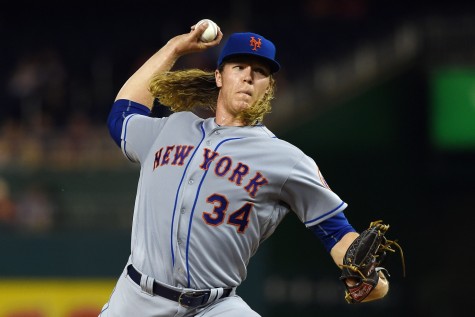
MMO: I was wondering your thoughts on a trade that wasn’t included in your book, the Mets and Blue Jays deal that saw R.A. Dickey, Josh Thole, and Mike Nickeas shipped off to Toronto with Travis d’Arnaud, Noah Syndergaard, John Buck, and Wuilmer Becerra coming back to New York. Was that a trade that you potentially thought of including in the book?
Shawn: That was a trade that I thought about a great deal including in the book, and I think, at that point, it has as much to do with the stories behind it as everything else. There’s only so much room and okay, is this story different enough from the others that we can include it?
I definitely looked into that trade and that’s a good example of what Tom Greive said – and I use that quote in my introduction – that a good trade in a general manager’s mind is you shake hands with the other guy and you’re happy with what you got back that day. Then you bump into him five years later and you can still shake hands and you’re happy with what you got.
There are just different time frames of what you’re looking for. In that case, the Blue Jays wanted something right away and needed a Cy Young-quality pitcher to add to their rotation, because they thought they could make some noise in the American League East. On the other hand, the Mets were looking to add prospects, and so I think they’re very, very happy with what they got. The Blue Jays were very happy, at least for a while, with what they got.
I think that’s a good example of a trade that, again, looking at the best interest of a baseball perspective, that’s a good trade because both teams got exactly what they were looking for.
MMO: Thanks so much for your time today, Shawn. Best of luck with the book.
Shawn: Thanks a lot, Mathew. Take care.


